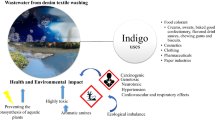Abstract
In this study Aspergillus oryzae was utilized to remove azo dyes from aqueous solution. Physically induced in its paramorphogenic form to produce standardized mycelial pellets, the non-autoclaved and autoclaved hyphae biomass was applied to biosorb the reactive dyes Procion Red HE7B (PR-HE7B) and Procion Violet H3R (PV-H3R) at different pH values (2.50, 4.50, and 6.50). The best pH for biosorption was 2.50, though the autoclaved demonstrated a higher biosorption capacity than the non-autoclaved pellets. The toxicity level was determined using the Trimmed Spearman–Karber method with Daphnia similis in all bioassays. The calculated toxicity of PV-H3R (LC100 62.50 μg mL−1) was higher than to PR-HE7B (LC100 300.00 μg mL−1), and its results brought out that the decrease of toxicity levels to zero might be accomplished by adding small quantities of pelletized A. oryzae to the solutions.


Similar content being viewed by others
References
Aksu Z (2005) Application of biosorption for the removal of organic pollutants: a review. Process Biochem 40:997–1026
Aksu Z, Karabayır G (2008) Comparison of biosorption properties of different kinds of fungi…, Bioresour. Technol. doi:10.1016/j.biortech.2008.01.056
Abraham TE, Senan RC, Shaffiqu TS, Roy JJ, Poulose TP, Thomas PP (2003) Bioremediation of textile azo dyes by an aerobic bacterial consortium using a rotating biological contactor. Biotechnol Prog 19:1372–1376
Ali N, Ikramullah, Lutfullah G, Hameed A, Ahmed S (2008) Decolorization of Acid red 151 by Aspergillus niger SA1 under different physicochemical conditions. W J Microbiol Biotechnol 24:1099–1105
Brazilian Environmental Sanitation Technology Company (CETESB) (1992) Análise estatística de resultados de testes de toxicidade aguda. In Norma Cetesb L5.017, CETESB, São Paulo, pp. 20
Dafale N, Rao NN, Meshram SU, Satish R, Wate SR (2008) Decolorization of azo dyes and simulated dye bath wastewater using acclimatized microbial consortium—Bioestimulation and halo tolerance. Biores Technol 99:2552–2558
Duffus JH (1983) Toxicologia Ambiental. Ediciones Omega SA, Barcelona, pp 1–157
Fu Y, Viraraghavan T (2001) Fungal decolorization of dye wastewaters: a review. Biores Technol 79(3):251–262
Fu Y, Viraraghavan T (2002) Removal of Congo Red from an aqueous solution by fungus Aspergillus niger. Adv Environ Res 7:239–247
Hamilton MA, Russo RC, Thurston RV (1977) Trimmed Spearman-Karber Method for estimating median lethal concentrations in toxicity bioassays. Environ Sci Technol 11:714–718
Head IM (1998) Bioremediation: towards a credible technology. Microbiol 144(3):599–608
Hong L, Li M-H (2007) Acute of 4-Nonylphenmol to aquatic invertebrates in Taiwan. Bull Environ Contam Toxicol 78:445–449
Iscen CF, Kiran I, Ilhan S (2007) Biosorption of reactive Black 5 dye by Penicillium restrictum. The kinetic study. J Haz Mat 143:335–340
Kapoor A, Viraraghavan T (1995) Biosorption—an alternative treatment option for heavy metal bearing wastewaters: a review. Biores Technol 53(3):195–206
Kumari K, Abraham TE (2007) Biosorption of anionic textile dyes by nonviable biomass of fungi and yeast. Biores Technol 98(9):1704–1710
Levine WC (1991) Metabolism of azo dyes: implication for detoxification and activation. Drug Metab Rev 23:253–309
Lima EC, Royer B, Vaghetti JCP, Simon NM, Cunha BM, Pavan FA, Benvenutti EV, Cataluna-Veses R, Airoldi C (2008) Application of Brazilian pine-fruit shell as a biosorbent to removal of reactive red 194 textile dye from aqueous solution: kinetics and equilibrium study. J Haz Mat 155:536–550
Marcanti-Contato I, Corso CR, Oliveira JE (1997) Induction of physical paramorphogenesis in Aspergillus sp. Braz J Microbiol 28:65–67
Mondal S (2008) Methods of dye removal from dye house effluent—an overview. Environ Eng Sci 25(3):383–396
O’Mahony T, Guibal E, Tobin JM (2002) Reactive dye biosorption by Rhizopus arrhizus biomass. Enz Microbiol Technol 31:456–463
Özer AA, Akkayaa G, Turabik M (2005) The absorption of Acid Red 337 and Acid Blue 324 on Enteromorpha prolifera the application of non linear regression analysis to biosorption. Chem Engin J 112:181–190
Pallu APS (2006) Biossorção de cádmio por linhagens de Aspergillus sp$ Master thesis, ESALQ-USP - Escola Superior de Agricultura Luis de Queiroz. Piracicaba, São Paulo State, Brazil, p 70
Pandey A, Selvakumar P, Soccol CR, Ningam P (1999) Solid state fermentation for production of industrial enzymes. Curr Sci 77:149–161
Pandey A, Singh P, Iyengar L (2007) Bacterial decolorization and degradation of azo dyes. Int Biodet Biodeg 59(2):73–84
Parshetti GK, Kalme SD, Gomare SS, Govindwar SP (2007) Biodegradation of Reactive blue-25 by Aspergillus achraceus NCIM-1446. Biores Technol 98:3638–3642
Pontecorvo G, Roper JA, Hemmons LM, McDonald KD, Bufton WFC (1953) The genetics of Aspergillus nidulans. Adv Genet 5:141–238
Rao JR, Viraraghavan T (2002) Biosorption of phenol from an aqueous solution by Aspergillus niger biomass. Biores Technol 85(2):165–171
Rieger PGJ, Meier HM, Gerle M, Vogt U, Groth T, Knackmuss H-J (2002) Xenobiotics in the environment: present and future strategies to obviate the problem of biological persistence. J Biotechnol 94:101–123
Robinson T, Mcmullan G, Marchant R, Ningam P (2001) Remediation of dyes in textile effluents: a critical review on current treatment technologies with a proposal alternative. Biores Technol 77(3):247–255
Schneider K, Hafner C, Jager I (2004) Mutagenicity of textile dye products. J Appl Toxicol 24:83–91
Volesky B (2001) Detoxification of metal-bearing effluents: biosorption for the next century. Hydrometallurgy 59:203–216
Yesilda O, Cing S, Asma D (2002) Decolourisation of the textile dye Astrazon Red FBL by Funalia trogii pellets. Biores Technol 81:155–157
Wang Y, Yu J (1998) Adsorption and degradation of synthetic dyes on the mycelium of Trametes versicolor. Water Sci Technol 38:233–238
Willmott N, Guthrie J, Nelson G (1998) The biotechnology approach to colour removal from textile effluents. JSDC 114:38–41
Acknowledgments
PROAP/CAPES, FAPESP, FUNDUNESP, and CNPQ
Author information
Authors and Affiliations
Corresponding author
Rights and permissions
About this article
Cite this article
Corso, C.R., Maganha de Almeida, A.C. Bioremediation of Dyes in Textile Effluents by Aspergillus oryzae . Microb Ecol 57, 384–390 (2009). https://doi.org/10.1007/s00248-008-9459-7
Received:
Accepted:
Published:
Issue Date:
DOI: https://doi.org/10.1007/s00248-008-9459-7




